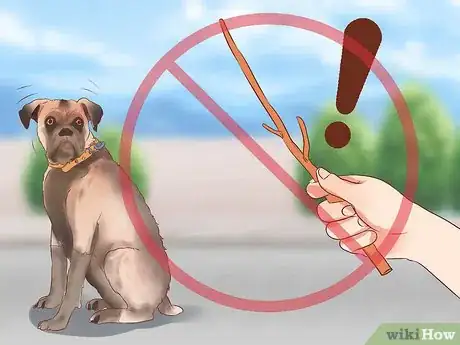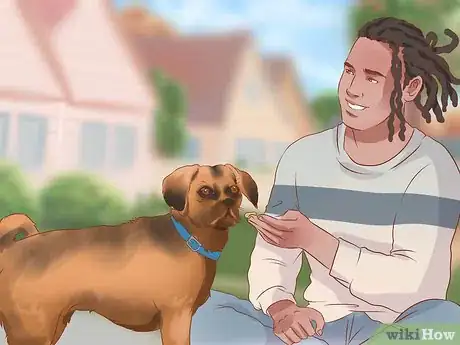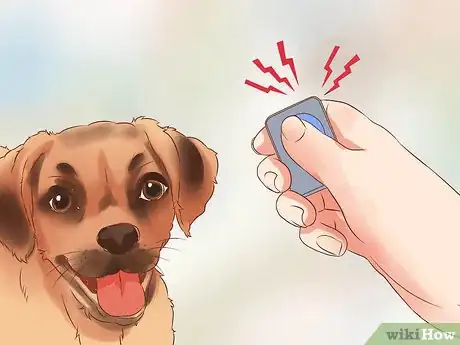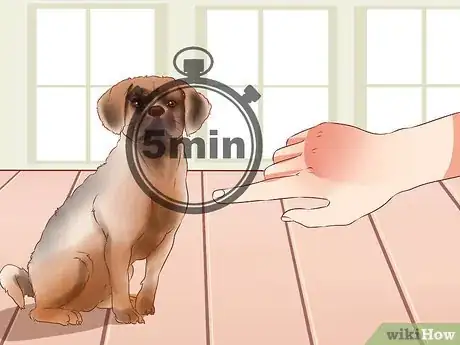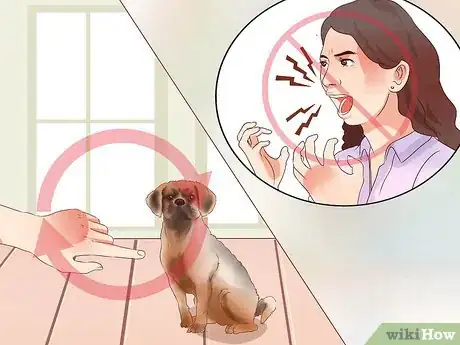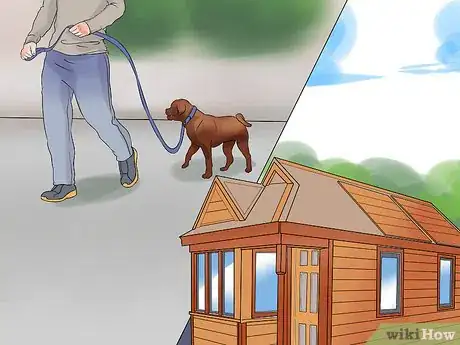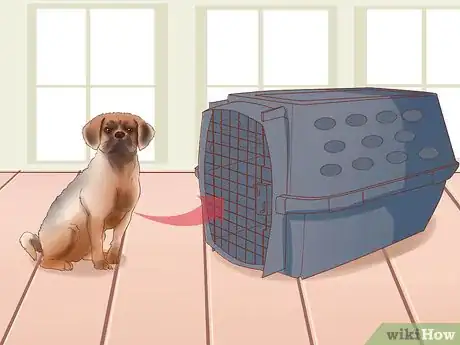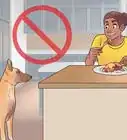This article was co-authored by Brian Bourquin, DVM and by wikiHow staff writer, Jessica Gibson. Brian Bourquin, better known as “Dr. B” to his clients, is a Veterinarian and the Owner of Boston Veterinary Clinic, a pet health care and veterinary clinic with three locations, South End/Bay Village, the Seaport, and Brookline, Massachusetts. Boston Veterinary Clinic specializes in primary veterinary care, including wellness and preventative care, sick and emergency care, soft-tissue surgery, dentistry. The clinic also provides specialty services in behavior, nutrition, and alternative pain management therapies using acupuncture, and therapeutic laser treatments. Boston Veterinary Clinic is an AAHA (American Animal Hospital Association) accredited hospital and Boston’s first Fear Free Certified Clinic. Brian has over 19 years of veterinary experience and earned his Doctor of Veterinary Medicine from Cornell University.
There are 13 references cited in this article, which can be found at the bottom of the page.
This article has been viewed 19,103 times.
If you have a puggle, you know how delightful, curious, and headstrong the breed can be. This cross between a pug and a beagle is notorious for loving food. Although puggles are easily distracted by searching for things to eat, you can motivate the puggle to train. Simply use food as a reward and learn how your puggle learns best. You'll soon be able to housebreak your puggle and teach it basic commands.[1]
Steps
Motivating Your Puggle
-
1Keep food treats on hand.[2] New dog training methods recommend rewarding and encouraging your dog, instead of punishing it. Fortunately, your puggle will do almost anything for food rewards. You can use some of your puggle's daily kibble ration or other healthy treats as a reward. Consider keeping treats in your pocket so you can train your puggle at any point throughout the day.[3]
- If your dog is eating healthy treats instead of its daily kibble ration, you may need to cut back on the amount of food it gets at meals. You don't want your puggle gaining weight because of training.
-
2Avoid using harsh punishments to train. Never hit or yell at your puggle to punish it. Although your dog may respond to the harsh treatment, it is acting out of fear of punishment instead of learning what is and isn't appropriate behavior. Using harsh treatments will just teach your dog to fear you since it doesn't understand why you're punishing it.[4]
- Physical punishment can make your puggle frustrated or anxious. This may cause pent up anger issues that make your dog aggressive.
Advertisement -
3Use positive reinforcement. Your puggle will respond well to reward-based training. To do this, reward your dog when it follows a command. You can use food, verbal praise, or play time with toys as rewards. Just find out what your dog enjoys best and use that as a reward. If your puggle seems distracted, use simple rewards for simple commands. Save more exciting or tasty rewards for bigger commands. This way, you can reward your dog's good attention with really tasty rewards.[5]
- Positive reinforcement will also make your puggle more loyal to you since it will be watching you for opportunities to earn treats.
-
4Consider clicker training your puggle. Purchase a clicker device and teach your dog to associate the clicking sound with a reward for obeying a command. You can do this by clicking the device and giving your puggle a food treat. When you're training your puggle, you should click the device and give it a treat whenever it obeys a command. Your puggle will learn to associate proper behavior with the clicker sound.[6] [7]
- For example, if you're teaching your puggle to come, begin clicking as soon as your dog turns in your direction. Continue to click until it comes to you and give a reward when it completes the command.
- Just remember, clicker training might take a while, so be patient.
-
5Keep training sessions short. Your puggle has a short attention span so you should do several 5 minute training sessions spaced throughout the day. This is better than one long training session. You can gradually increase the length of the training session as your puggle's concentration improves. Always end training while your puggle is happy and pleased (you'll notice its tail wagging). This way your puggle looks forward to the next training session.[8]
- If your puggle gets distracted during training, give a simple command that you know it can do and end the session. This will end the session on a positive note.
-
6Be patient with your puggle. You may be frustrated with your puggle's tendency to suddenly go off and follow a scent. This is a well-known characteristic of the beagle breed and one of the reasons that training puggles is challenging. Remember that your puggle is an intelligent dog. Be prepared to put in lots of training hours and don't be discouraged.[9]
- Don't expect results over night. Training will take consistent effort and practice.
House-Training Your Puggle
-
1Begin training your puggle right away. You should begin house training your puggle as soon as you bring it home. Take your puggle straight out to the spot where you want it to toilet. Pop your dog on the spot and reward it with verbal praise if it happens to toilet. Lots of verbal praise will encourage your dog to wait and toilet in the correct place.[10]
- Make sure you set up a puppy room where your dog will sleep and eat. This way, your puggle won't roam around your house, which could make house training more difficult.
-
2Put your puggle on a training schedule. If you have a young puggle (around 8 weeks old or less), take your puppy outside every 20 to 30 minutes. If you have an older puggle, take the dog to the toileting spot about 20 minutes after eating since most dogs tend to toilet after meals. If your dog is outside and showing signs of needing to eliminate, pick it up and put it on the toilet spot. [11]
- Signs that your dog needs to toilet include sniffing with concentration or sneaking up to objects.
-
3Clean up any accidents right away. Your puggle will probably have a few accidents before you completely house train it. React calmly and quickly clean up the accident. Be sure to thoroughly clean the mess so your dog won't return to the spot to toilet again. You'll need to use an enzymatic cleaning product designed to remove pet urine.[12]
- Avoid punishing your dog since it won't associate the punishment with the action of toileting in the wrong place.
-
4Prepare a crate for your puggle.[13] You may need to safely crate your dog when you won't be home for a while. Purchase a crate that's large enough for a full-grown puggle to completely turn around in. Since adult puggles usually range from 15 to 30 pounds, you'll need a crate about 24" by 24." Fill it with a comfortable bed, a water bowl, and some toys. These things will make your puggle feel comfortable and secure.[14]
- Staying in a crate teaches your dog some bladder control since your puggle is less likely to soil its crate or den.
- Leave treats in the crate for your puggle to discover. Let it wander in and snack, but leave the door open.
-
5Teach your dog to use the crate. Let your puggle become familiar with the comfortable crate while keeping the door open. Once your dog has checked out the crate a few times, begin closing the door just for a few seconds. Praise your puggle if he remains calm. Gradually extend the amount of time you keep the door closed so that your puggle is just as happy with the door closed as with it open.[15]
- Avoid letting your puggle out when it cries (as long as you're sure it doesn't need to toilet). Doing so conditions your dog to expect release whenever it cries. Instead, wait until your dog is quiet and then let it out so that good behavior is rewarded.
Teaching Basic Commands
-
1Use food to teach your puggle to sit. Hold a small food treat between your finger and thumb so that the treat is just in front of your puggle's nose. Add the command "sit" as you show it the treat. When you have its attention, raise the treat in an arc going back over its head. As its nose follows the treat, the puggle's bottom naturally sinks to the ground. As soon its bottom contacts the floor, press the clicker and give the treat.[16]
- Repeat the command until your puggle quickly obeys to just the verbal command.
-
2Train your dog to stay. Once your puggle has learned the sit command, have it sit. Hold up your hand so that your palm faces your dog in a stop signal. Firmly say "stay" and take a small step back. Wait for a few seconds to make sure your puggle doesn't move, then pat your thighs and call the puppy's name. Say "come" using a playful bright voice.[17]
- Remember to reward your puggle with treats or praise when it runs to you. If your dog is struggling to follow the command, make it sit and try again, holding the stay command for a shorter amount of time.
-
3Teach your puggle to come. Play with your puggle in a large fenced in area that's somewhat free of distractions. Take several steps away from your dog. Wave a treat in your hands and say "come" in an excited voice. Give it praise as soon as it begins running towards you and reward with the treat and a click.[18]
- If your dog doesn't come to you, avoid punishing it. Jog backwards a little and clap your hands while calling its name. Your puggle may think you're playing a game and will want to run towards you.
-
4Consider adding more complex commands. Once your puggle has mastered simple commands, you can train it to do more complicated commands or tricks. Just make sure not to overwhelm your puggle. When teaching a complex trick, break it down into individual components. This way, you can teach one element at a time before adding them together for the complete trick.
- Remember, your puggle will be easily distracted. Teach commands in different environments so it learns to obey you no matter where you are, rather than only when you are at home.
References
- ↑ http://dogtime.com/dog-breeds/puggle#/slide/1
- ↑ Brian Bourquin, DVM. Veterinarian. Expert Interview. 20 December 2019.
- ↑ https://www.dogstrust.org.uk/help-advice/factsheets-downloads/basicdogtrainingfactsheetnov13.pdf
- ↑ https://www.animalhumanesociety.org/training/reasons-aggression-dogs
- ↑ https://www.dogstrust.org.uk/help-advice/factsheets-downloads/basicdogtrainingfactsheetnov13.pdf
- ↑ http://www.whole-dog-journal.com/issues/9_3/features/Training-Your-Dog-Using-Shaping_15792-1.html
- ↑ http://www.clickertraining.com/get-started
- ↑ https://www.dogstrust.org.uk/help-advice/factsheets-downloads/basicdogtrainingfactsheetnov13.pdf
- ↑ https://www.dogstrust.org.uk/help-advice/factsheets-downloads/basicdogtrainingfactsheetnov13.pdf
- ↑ http://www.thekennelclub.org.uk/getting-a-dog-or-puppy/general-advice-about-caring-for-your-new-puppy-or-dog/toilet-training-for-puppies/
- ↑ http://www.thekennelclub.org.uk/getting-a-dog-or-puppy/general-advice-about-caring-for-your-new-puppy-or-dog/toilet-training-for-puppies/
- ↑ http://www.humanesociety.org/animals/dogs/tips/housetraining_puppies.html
- ↑ Brian Bourquin, DVM. Veterinarian. Expert Interview. 20 December 2019.
- ↑ https://apdt.com/resource-center/choosing-right-crate-size/
- ↑ http://www.humanesociety.org/animals/dogs/tips/crate_training.html
- ↑ http://dogtime.com/reference/dog-training/16598-teaching-sit-6-months-and-up
- ↑ http://dogtime.com/dog-health/general/90-basic-commands-obedience-stay
- ↑ http://dogtime.com/dog-health/general/88-basic-commands-obedience-come
About This Article
To train puggles, spread your training out over 5 minute sessions throughout the day since the breed is known for having a short attention span. Food is a great motivator for puggles, so use your puggle’s daily kibble ration or other healthy treats as rewards during training. If you want to house train your puggle, take it to the spot outside where you want it to toilet and reward it with verbal praise if it goes. You should also put it on a training schedule for when you take it outside, which would be every 20 to 30 minutes for a puppy. For more tips from our Veterinary co-author, including how to teach your puggle to stay, read on!


